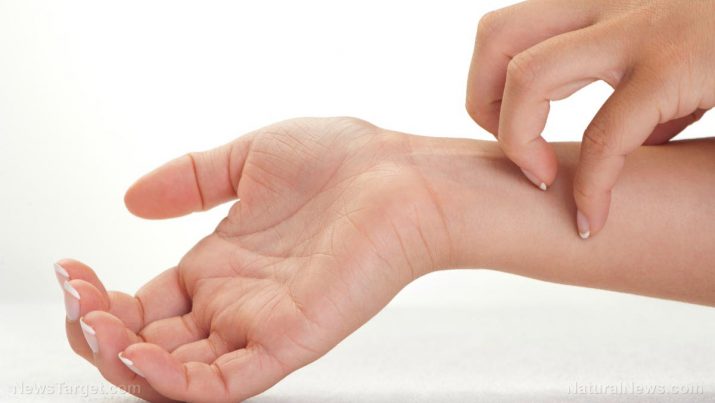
Herpes Zoster – causes, side effects and treatments at NaturalPedia.com
Tuesday, April 17, 2018 by Zoey Sky
http://www.naturalpedia.com/herpes-zoster-causes-side-effects-and-treatments-at-naturalpedia-com.html

Herpes zoster, also called shingles, is a viral disease caused by the varicella-zoster virus. This is the same virus that also causes chickenpox.
The varicella-zoster virus may remain in the nervous system even years after the chickenpox infection is over before it reactivates as herpes zoster. The infection usually clears up after two to three weeks. An individual will rarely get infected with herpes zoster more than once.
However, according to the Centers for Disease Control and Prevention (CDC), about one in three people in the U.S will have herpes zoster in their lifetime.

Known side effects of herpes zoster
The initial side effects of herpes zoster often include pain and a burning sensation. The pain is commonly felt on one side of the body in small patches followed by a red rash.
Herpes zoster rash characteristics may include:
- Fluid-filled blisters that burst easily
- Itching
- A rash on the face and ears
- A rash that spreads from the spine to the torso
- Red patches
Some patients experience side effects aside from pain and rash. These may include:
- A fever
- Chills
- Fatigue
- A headache
- Muscle weakness
Risk factors for herpes zoster may include:
- Being older that 60
- Having diseases that weaken the immune system (e.g. AIDS, cancer, or HIV)
- Having undergone chemotherapy or radiation treatment
- Taking drugs that weaken the immune system (e.g. steroids or medications prescribed following an organ transplant)
Body systems harmed by herpes zoster
Herpes zoster may cause the following complications:
- Blindness
- Brain inflammation/encephalitis
- Death
- Eye complications – When a rash or blister forms near the eye, it can result in vision loss.
- Hearing problems
- Pneumonia
- Postherpetic neuralgia (PHN) – The most common complication of herpes zoster, PHN causes severe pain in the areas where patients have had the rash, even after it clears up. While the pain caused by PHN can be serious and debilitating, it often resolves after several weeks or months. In some cases, patients may experience pain due to PHN for many years, which can negatively affect daily life.
Food items or nutrients that may prevent herpes zoster
The following foods or nutrients can help prevent herpes zoster:
- Fruits and vegetables — Fruits and vegetables are full of essential micronutrients that your body requires to build and maintain immunity.
- Garlic — Garlic is rich in antioxidants. It’s also a natural antibiotic. Additionally, garlic can help blisters heal faster.
- Lysine — Lysine, an amino acid, can inhibit the multiplication of the herpes zoster virus. Foods rich in lysine include beans, dairy products, fish, and red meat.
- Seaweed — Seaweed can help prevent the herpes zoster virus from spreading to the nerves, which can prevent shingles.
- Vitamin B-6 — This nutrient is good for the nerves. Sources include bananas, nuts, and potatoes.
- Water — Staying hydrated can help your body flush out the impurities from your system.
- Whole grain foods — Sources include brown rice and oatmeal.
Treatments, management plans for herpes zoster
While there’s no cure for herpes zoster, prescribed medication can ease symptoms and hasten the patient’s recovery.
- Anticonvulsants or tricyclic antidepressants — Helps ease prolonged pain.
- Antihistamines like diphenhydramine (Benadryl) — Can treat itching.
- Anti-inflammation drugs (e.g. Ibuprofen) — Helps ease pain and swelling.
- Anti-viral medications (e.g. acyclovir, valacyclovir, and famciclovir) — Helps reduce pain and hasten recovery.
- Capsaicin (Zostrix) — Help reduce the risk of PHN.
- Numbing creams, gels, or patches (e.g. lidocaine) — Helps reduce pain.
Where to learn more
- Shingles vaccine made with pig gelatin, MSG and residual components of human DNA from an aborted fetus. Why?
- Shingles vaccines scientifically proven to cause chicken pox outbreaks
- Thousands damaged by shingles vaccine are trying to sue Merck
- Trading chickenpox for shingles
- Wipe out shingles FAST with easy-to-use homeopathic remedies – relieve pain, eliminate burning, itching and infection
Summary
Herpes zoster, also called shingles, is a viral disease caused by the varicella-zoster virus. This is the same virus that also causes chickenpox. The varicella-zoster virus may remain in the nervous system even years after the chickenpox infection is over before it reactivates as herpes zoster.
The initial side effects of herpes zoster often include pain and burning. The pain is commonly felt on one side of the body in small patches followed by a red rash.
Herpes zoster rash characteristics may include fluid-filled blisters that burst easily, itching, a rash on the face and ears, a rash that spreads from the spine to the torso, and red patches.
Herpes zoster may cause complications like blindness, brain inflammation/encephalitis, death, eye complications, hearing problems, or pneumonia.
Fruits and vegetables, garlic, lysine, seaweed, vitamin B6, water, and whole grain foods can help prevent herpes zoster.
While there’s no cure for herpes zoster, medication may be prescribed to ease symptoms and hasten the patient’s recovery.
Sources include
Tagged Under: Tags: herpes zoster





